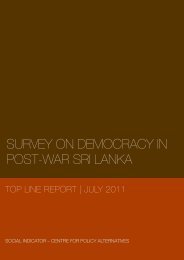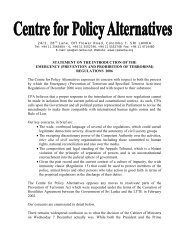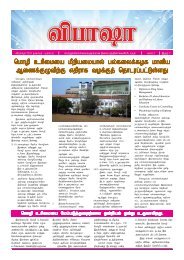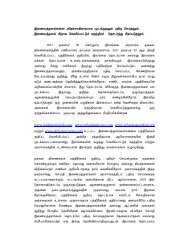States of Emergency - Centre for Policy Alternatives
States of Emergency - Centre for Policy Alternatives
States of Emergency - Centre for Policy Alternatives
You also want an ePaper? Increase the reach of your titles
YUMPU automatically turns print PDFs into web optimized ePapers that Google loves.
eLlection <strong>of</strong> the high importance accorded to fundamental rights<br />
by the constitutional order introduced in 1978. 329 However, case<br />
law from the early years <strong>of</strong> the constitution evinces a general<br />
attitude <strong>of</strong> difLidence in developing its fundamental rights<br />
jurisdiction, and showed extreme deference to the executive in<br />
circumstances <strong>of</strong> public emergency. This changed later when the<br />
Supreme Court demonstrated a more aggressive approach to<br />
holding the executive to account and in developing its<br />
fundamental rights jurisprudence.<br />
Thus, the rendering <strong>of</strong> the Supreme Court as a court <strong>of</strong> Lirst<br />
instance has resulted in a mixed experience. On the one hand, the<br />
Supreme Court has been able to assert itself against the executive<br />
in states <strong>of</strong> emergency in a way a lower court would have found<br />
difLicult. This was especially true during the late 1980s and 1990s<br />
when the Supreme Court was at its apogee as the guardian <strong>of</strong><br />
fundamental rights against a rampant executive in a particularly<br />
challenging security context. On the other hand, the theoretical<br />
clarity and the development <strong>of</strong> general principles with regard to<br />
the judicial interpretation <strong>of</strong> the bill <strong>of</strong> rights have suffered as a<br />
result <strong>of</strong> case law dominated by questions <strong>of</strong> fact.<br />
The judicial response to review <strong>of</strong> procedural and substantive<br />
executive action in states <strong>of</strong> emergency will be discussed further<br />
below. Given, however, that during the thirty years <strong>of</strong> existence <strong>of</strong><br />
the present constitution, the state <strong>of</strong> emergency has been the<br />
norm rather than the exception, the vast majority <strong>of</strong> fundamental<br />
329<br />
See Parliamentary Series No.14 <strong>of</strong> the Second National State Assembly<br />
(1978) Report <strong>of</strong> the Select Committee <strong>of</strong> the National State Assembly <br />
appointed to consider the revision <strong>of</strong> the Constitution, 22 nd June 1978: p.<br />
141; Draft Chapter III: p.526; See also A.J. Wilson (1980) The Gaullist <br />
System in Asia: The Constitution <strong>of</strong> Sri Lanka (1978) (London:<br />
Macmillan): Ch.6<br />
214











